Energy Innovation partners with the independent nonprofit Aspen Global Change Institute (AGCI) to provide climate and energy research updates. The research synopsis below comes from AGCI Program Director Emily Jack-Scott and AGCI Program Associate Devan Crane. A full list of AGCI’s updates covering recent climate change and clean energy pathways research is available online at https://www.agci.org/solutions/quarterly-research-reviews.
Recent research highlights how 65 percent of food system emissions come from the production, processing, transport, and consumption of just four emissions-intensive foods: beef, milk, rice, and corn (maize).
Faced with high food prices and continuous disruptions to supply chains, many households in the United States are appreciating afresh what it takes to grow, gather, and deliver the food they consume on a daily basis. But what the average consumer may not fully recognize is the extent to which their everyday food choices contribute to emissions of greenhouse gasses (GHGs). The food system as a whole accounts for a whopping 35 percent of global emissions, and consumer decisions like diet and shopping patterns greatly influence those emissions.
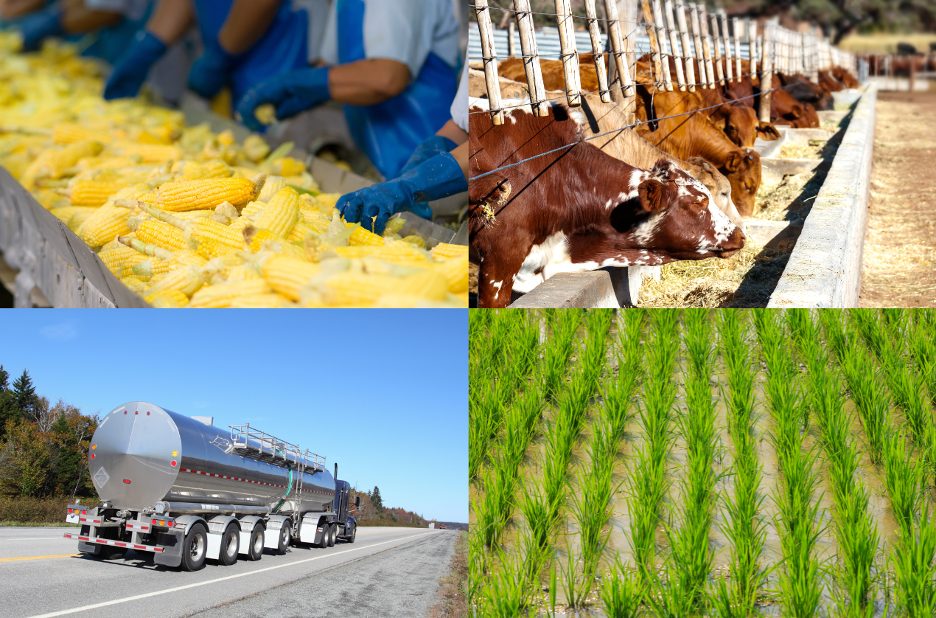
Emerging research is beginning to shed light on actions that consumers and producers can take to reduce food system impacts on the climate and move toward a “net-zero” system in which all emissions produced are offset by sequestration processes.
Emissions from farm to table to landfill
Emissions are generated at every stage of the food system, from the production of food on farms to transport and refrigeration to processing and packaging to consumer dietary choices and, ultimately, to food waste. Seventy percent of total food system emissions come from land-use change. For example, when a forest—which naturally absorbs and stores carbon dioxide as trees grow—is logged and converted to grazing or agricultural land, GHGs are released as trees decompose. Additional emissions result from tilling soils and applying fertilizers for agricultural production. The remaining food system emissions are attributable to other stages such as transport, packaging, and waste. With rising populations and growing appetites for emissions-intensive foods, emissions are projected to increase 50 percent by 2050 under business-as-usual conditions.
In a 2022 paper published in Nature Scientific Reports, Ciniro Costa, Jr., and colleagues highlight how 65 percent of food system emissions come from the production, processing, transport, and consumption of just four foodstuffs: beef, milk, rice, and corn (maize). By focusing on these emissions-intensive foods, the authors modeled 60 scenarios of interventions that could reduce emissions across the global food system. They found that a net-zero food system could be achieved through widespread adoption of system-wide efficiency improvements, shifts toward plant-forward diets, nature-based sequestration, and adoption of emerging technologies.
Most of the low-emissions interventions analyzed (70 percent) utilize existing know-how and technologies: reducing deforestation, better managing manure, improving feed and breeding (which can reduce methane emissions from livestock), reducing nitrogen fertilizer overuse and runoff, and adopting renewable energy and energy efficiency. Sequestration approaches such as agroforestry and low- or no-till agriculture also have significant co-benefits such as soil and water conservation. Greater adoption of low-emissions practices means less reliance on sequestration will be needed to achieve a net-zero emissions food system.
Emissions from food loss and waste
Reducing food loss and waste is an additional practice that Costa and colleagues emphasize. Food loss and waste alone account for 8-10 percent of all global GHG emissions (Ribbers et al., 2022), with approximately 1.3 billion tons of food perishing annually (Ouro-Salim and Guarieri, 2021). Food loss and food waste are often considered in tandem, but they are distinct issues. Food loss typically refers to loss of edible food before harvest or in the supply chain (e.g., due to inability to harvest all of a crop before it begins to rot, or poor refrigeration during transport). Food waste, by contrast, refers to loss of edible food due to consumer behavior, (e.g., over-ordering at a restaurant or poor planning that leads to groceries expiring and becoming inedible) (Kumar et al., 2022).
Notably, there are significant differences between high-income and low-income countries when it comes to food loss and waste. In high-income countries, food waste makes up 50 percent of overall losses, whereas food waste in low-income countries accounts for only 5 percent of overall losses (Kumar et al., 2022). In low-income countries, food loss is more of a problem and typically results from systemic challenges, such as lack of access to non-local markets, storage, transportation, refrigeration, and harvesting technology (Ouro-Salim and Guarieri, 2021). Reducing food waste in high-income countries is largely a voluntary act for the consumer, with very few waste-reduction enforcement policies in place (Stancu and Lähteenmäki, 2022).
Food waste can also vary by type of food, and high-nutrition foods like fresh produce are especially at risk of waste. Qin and Horvath found in their 2022 study published in Resources, Conservation & Recycling that in the U.S., household food waste can be the largest source of food loss emissions. In the case of cherries, for instance, extreme loss and waste nearly triple emissions: for every kilogram (2.2 lbs) of cherries consumed by a household, another kilogram is lost during production and transit, and a third kilogram is wasted post-purchase (see Figure 1).
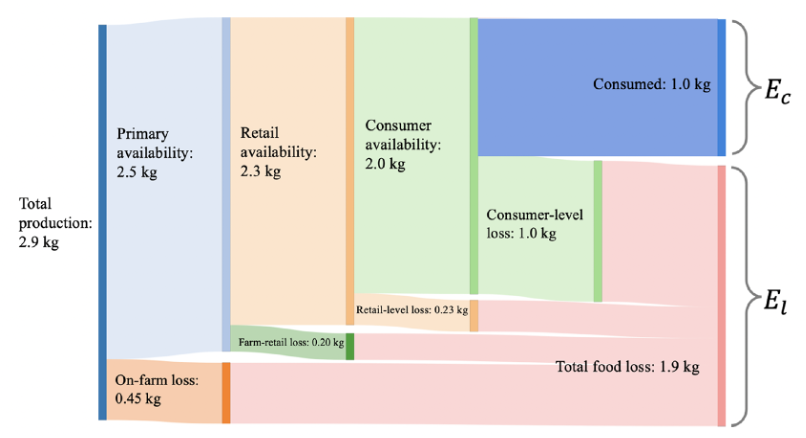
Reducing food loss and waste is one way households and individuals have the power to significantly reduce their climate impact, especially in high-income countries. So what holds us back? Why do so many U.S. consumers waste food, especially when it is increasingly expensive and in some instances sporadically available? And what other choices can consumers make to reduce emissions from the food they eat?
Psychology of reducing food waste
In a 2022 paper in Food Policy, co-authors Violeta Stancu and Liisa Lähteenmäki examined food-related behaviors that contribute to consumer food waste, including consumer self-identities, purchasing tendencies, and disgust sensitivity (how easily disgusted a person is by a food’s perceived edibility). They argue that a better understanding of these drivers can help inform more targeted policy and public awareness campaigns.
In a related paper in Global Environmental Change led by Daphne Ribbers, researchers investigated behavioral motivations akin to the consumer self-identities outlined by Stancu and Lähteenmäki. While the two concepts are similar, motivation “can be defined as the process that determines the … direction of behavior, and is generally understood as the reason why humans continue, or terminate a specific behavior” (Ribbers et al., 2023), whereas self-identities refer to “behaviors that are in line with … the label that people use to describe themselves” (Stancu and Lähteenmäki, 2022). Both studies examined the environmental, moral, financial, and social dimensions of these drivers of behavior.
Stancu and Lähteenmäki found that individuals with frugal and environmental self-identities and in older demographics were less likely to waste food, whereas individuals prone to impulse buying, with high disgust sensitivity, and with higher incomes were more likely to waste food. They also found that in-store marketing and retail stimuli can influence individuals to purchase more than was planned (impulse buying), leading to food waste. These factors point to an opportunity for awareness campaigns that can help consumers limit impulse buying and adopt mindful shopping behaviors. Retailers could also be held accountable to reduce food waste by using marketing strategies that don’t prey on impulsive tendencies.
Individuals who are more easily disgusted by perceived food imperfections were also found to be more wasteful. The perception that food was inedible was largely influenced by misunderstanding the common food-labeling system of “best-by” and “use-by” dates. “Best-by” dates relate to food quality, whereas “use-by” dates relate to food safety. Checking edibility by smell or taste when a food is past its labeling date, rather than automatically tossing food, could reduce food waste. Education campaigns focused on increasing food labeling knowledge could help lessen confusion and reduce food being thrown out prematurely.
Ribbers and colleagues found that consumers who waste less food were significantly motivated by environmental and moral factors: awareness of environmental impacts or feeling guilt about wasting food. Interestingly, financial and social motivations (frugality or the concern of appearing wasteful to others, respectively) were not significant motivations to avoid food waste. The authors caution that there may be instances in which financial motivations are significant and may be intertwined with environmental and moral motivations. As in Stancu and Lähteenmäki’s study, Ribbers found that older people typically waste less food.
Both papers also noted that future research should focus on behaviors and culturally specific motivations for more targeted solutions and policy.
Individual actions to reduce food emissions
In addition to reducing food waste, individual consumers have opportunities to limit their food emissions footprint by reducing superfluous packaging and by embracing dietary shifts.
Often consumers only consider the food waste they can physically see and touch, (e.g., scraping a plate into the trash at the end of a meal or forgetting a leftover box the restaurant packed up). In reality, consumers contribute to an entire waste cycle that stems from the energy and water used during production, harvest, material extraction, packaging creation, packaging, transportation, storage, consumption, and wastage/misuse (see figure 2). Consumers should also consider the end-of-life consequences of waste: pollution, millennia-long breakdown times, and overflowing landfills (Qin and Horvath, 2022).
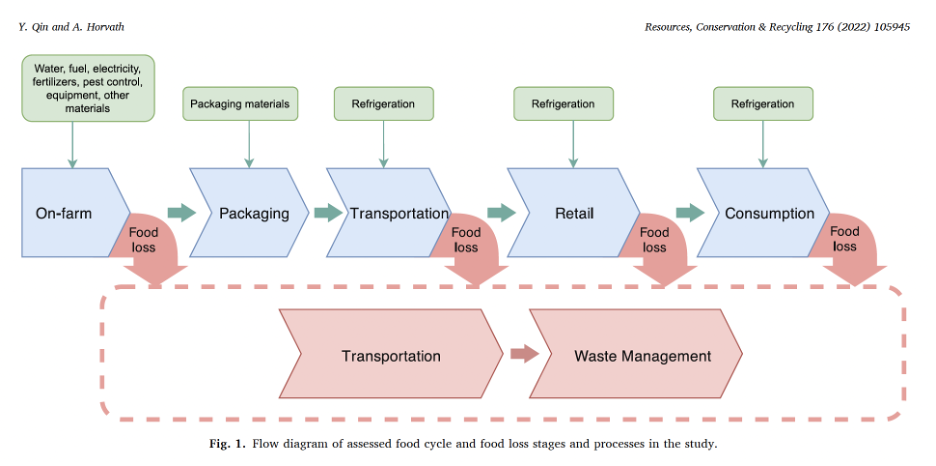
For instance, use of plastic packaging has increased sharply in recent decades, from 2 million tons in 1950 to 381 million tons in 2015. Some packaging helps reduce waste by extending the shelf life of foods and protecting them during transport, but not all packaging has the same emissions. In a 2022 analysis in Resources, Conservation and Recycling, co-authors Mengqing Kan and Shelie Miller focused on the environmental impacts of plastic packaging across a food’s entire lifecycle as well as its annual consumption. The authors then compared the energy used over various foods’ life cycles to equivalent vehicle emissions to put the results into more familiar terms for non-scientists.
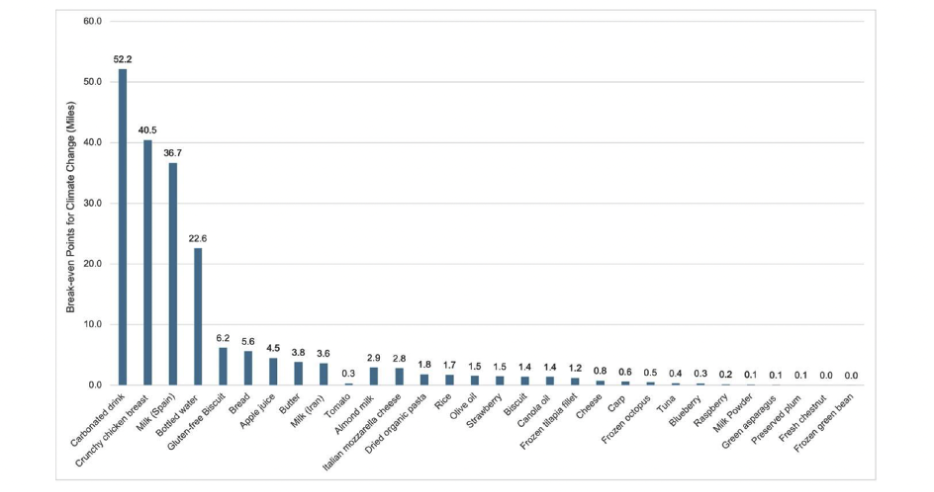
Kan and Miller found that, based on average US per capita annual consumption rates, while emissions from food packaging are significant, for most products they pale in comparison to per capita emissions from other everyday activities like driving. Most of the food packaging in the study had annual per capita emissions equivalent to less than a day of driving (the average person in the U.S. drives 30 miles per day). Notable exceptions included carbonated beverages, crunchy chicken breast, certain types of milk, and bottled water. The authors also note significant co-benefits to limiting packaging, such as reducing the environmental impacts of extraction and disposal, especially for products disposed of improperly.
Dietary shifts are another significant way consumers can limit their personal food emissions. Virtually all scenarios that point to a net-zero food system rely on consumers shifting to a more plant-forward diet, especially in high-income countries. Demand for livestock products like beef and milk must be reduced by 10-25 percent to attain low-emissions or net-zero goals (Costa et al., 2022).
Livestock contribute to food system emissions through the food they consume and excrete, as well as the water and land needed for their production. In a 2022 paper published in the Proceedings of the National Academy of Sciences, Claudia Arndt and colleagues studied several ways to reduce methane gas emissions from livestock without reducing productivity by changing their diet formulations and grazing practices alongside breeding and genetic standards. Several combinations of mitigation strategies even increased animal production. The study found that adoption of any one of these strategies alone would not attain global emissions reduction goals by 2030, but adopting multiple effective strategies would achieve target reductions.
Reducing emissions at the livestock production stage is critical to overall reduction of food system-related GHG emissions. But ultimately, consumer demand for livestock products must be curbed to lower overall emissions. Development of new plant proteins is one way to shift consumer diets to meat alternatives and meal substitutions (Costa et al., 2022).
Beyond individual actions
While individual consumers have a great deal of agency to curb emissions by reducing food waste and packaging and choosing more plant-forward diets, governments and investors must also design policies and financial mechanisms to lessen emissions throughout the food system.
Circular economy practices can help redirect food from landfills by donating still-good foods for human and animal consumption or channeling inedible foods to composting, bio products, and sewage/wastewater treatment facilities (Ouro-Salim and Guarieri, 2021).
In their scenarios to achieve a net-zero emissions food system, Costa and colleagues found that while most low-emissions interventions were based on existing technologies, only about 50 percent would be cost effective at a price less than $100/ton of carbon dioxide. They lay out the following timeline of actions most likely to achieve net-zero emissions while increasing production of food for growing populations, favoring the most cost-effective interventions in the near future:
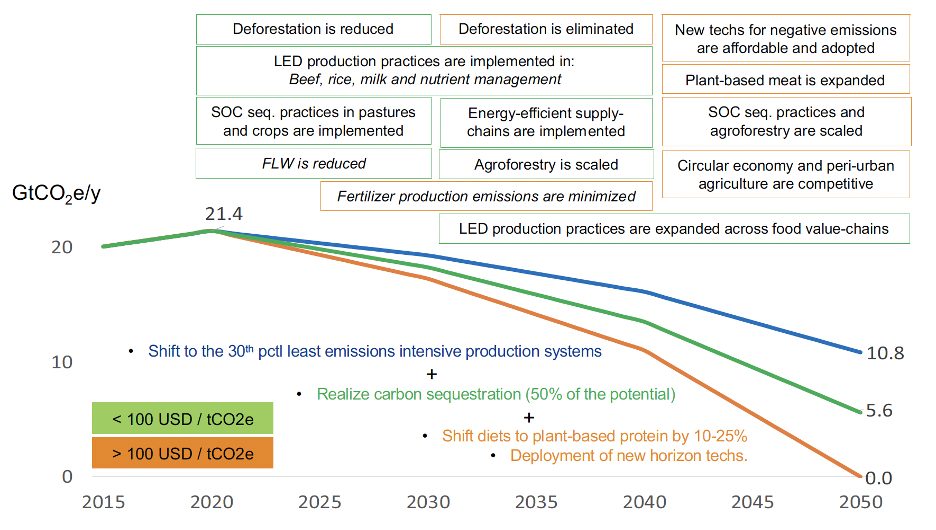
Governance and finance mechanisms will be needed to reduce deforestation and emissions from high-emitting crops and livestock and promote sequestration at the scale required to reduce global food emissions. For strategies that are already cost effective, traditional bank loans should be explored. To promote practices that are less cost effective, public dollars can be strategically invested in private ventures to reduce initial risks of early adoption and scale up carbon markets. The authors also spotlight the need for long-term philanthropic and patient private capital investments in high-risk emerging technologies.
Featured Research
Costa Jr, C., Wollenberg, E., Benitez, M., Newman, R., Gardner, N. and Bellone, F., 2022. Roadmap for achieving net-zero emissions in global food systems by 2050. Scientific Reports, 12(1), p.15064.
Kan, M. and Miller, S.A., 2022. Environmental impacts of plastic packaging of food products. Resources, Conservation and Recycling, 180, p.106156.
Kumar, S., Srivastava, M.S.K., Mishra, A. and Gupta, A.K., Ethically–Minded Consumer Behavior: Understanding Ethical Behavior of Consumer towards Food Wastage.
Ouro‐Salim, O. and Guarnieri, P., 2022. Circular economy of food waste: A literature review. Environmental Quality Management, 32(2), pp.225-242.
Qin, Y. and Horvath, A., 2022. What contributes more to life-cycle greenhouse gas emissions of farm produce: Production, transportation, packaging, or food loss?. Resources, Conservation and Recycling, 176, p.105945.
Ribbers, D., Geuens, M., Pandelaere, M. and van Herpen, E., 2023. Development and validation of the motivation to avoid food waste scale. Global Environmental Change, 78, p.102626.
Stancu, V. and Lähteenmäki, L., 2022. Consumer-related antecedents of food provisioning behaviors that promote food waste. Food Policy, 108, p.102236.